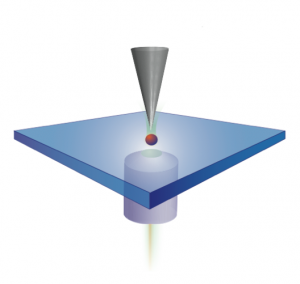Spatially Resolved Exciton Dynamics in Quantum Dot Thin Films
- Category: Energy, Materials, Nanotechnology, Optics & Photonics
- Tags: ferry prins, william tisdale
The diffusion of excitonic energy from within the photosensitive layer of a photovoltaic cell towards the charge separation interface is a crucial step in solar energy generation[1]. Depending on the material-type and its morphology, the length scale at which exciton diffusion occurs in nanostructured materials ranges from a few 10’s up to 100 nm[2]. To date, exciton diffusion in nanostructured materials has been studied using time-resolved spectroscopy. However, since these measurements are done on bulk volumes of the nanosctrutured materials, they are unable to resolve the nanoscopic details of the influence of the sample morphology on the energy transfer.
Currently, we are developing near-field optical techniques to study the flow of excitonic energy in colloidal quantum-dot thin films with nanometer-scale spatial resolution (see figure 1 for a schematic). While the resolution of conventional optical microscopy is fundamentally limited by the diffraction limit of light, near-field microscopy makes use of highly localized fields at the apex of a metal-coated atomic force microscopy (AFM-) tip. Such tip-enhanced microscopy techniques can reach optical resolutions as high as 15 nm, enough to resolve individual nano-objects such as colloidal quantum dots[3]. In addition to this unprecedented optical resolution, the AFM itself provides information about the morphology of the sample. The simultaneous acquisition of all these parameters allows us to correlate the dynamics of exciton diffusion with the local ordering and possible defects in the sample, information that is crucial to understand the limiting factors the diffusion length.
- R. Lunt et al., “Practical roadmap and limits to nanostructured photovoltaics,” Advanced Materials, vol. 23, pp. 5712-5727, 2011. [↩]
- B. Kippelen and J. L. Bredas, “Organic Photovoltaics,” Energy and Environmental Science, vol. 2, pp. 251-261, 2009. [↩]
- A. Hartschuh, “Tip-Enhanced Near-Field Optical Microscopy,” Angewandte Chemie, vol. 47, pp. 8178-8191, 2008. [↩]
